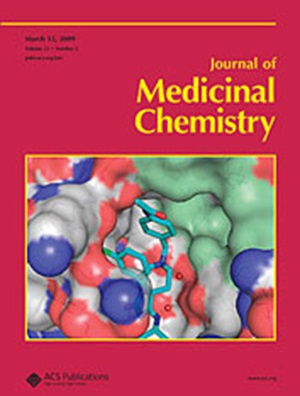Antibody-Drug Conjugates of NLRP3 Agonists: How Overcoming Lysosomal Accumulation Necessitated Noncanonical Linker Attachments
IF 6.8
1区 医学
Q1 CHEMISTRY, MEDICINAL
引用次数: 0
Abstract
An initial series of NLRP3 agonist antibody-drug conjugates (ADCs) failed to induce IL-1β in vitro due to lysosomal trapping of the payload. To address this, we developed assays and computational tools to identify a new payload that could diffuse out of the lysosomes. ADCs derived from this payload were active, emphasizing the need to avoid payload lysosomal accumulation for nonlysosomal targets. Two active ADCs necessitated attaching a cleavable valine-citrulline recognition element to the payload via a noncanonical ester linkage, rather than a canonical carbamate one, since the payload did not contain a basic amine. The citrulline stereocenter configuration was found to affect the payload release and in vitro activity. The ADC with the (L)-Val-(L)-Cit ester configuration showed superior in vitro activity, high stability in mouse serum, and rapid cleavage in human liver lysosomes. These properties suggest that this noncanonical (L)-Val-(L)-Cit ester attachment may be valuable to the ADC community moving forward.

NLRP3激动剂的抗体-药物偶联物:如何克服溶酶体积累需要非规范连接体附着
最初的一系列NLRP3激动剂抗体-药物偶联物(adc)由于有效载荷的溶酶体捕获而无法在体外诱导IL-1β。为了解决这个问题,我们开发了检测方法和计算工具来确定一种新的有效载荷,这种有效载荷可以从溶酶体中扩散出来。来自该有效载荷的adc是活跃的,强调需要避免非溶酶体靶标的有效载荷溶酶体积累。两个活性adc需要通过非规范酯连接连接可切割的缬氨酸-瓜氨酸识别元件,而不是规范氨基甲酸酯连接元件,因为有效载荷不含碱性胺。瓜氨酸立体中心构型对有效载荷释放和体外活性有影响。具有(L)- val -(L)- cit酯结构的ADC具有良好的体外活性,在小鼠血清中具有较高的稳定性,在人肝溶酶体中具有快速裂解能力。这些性质表明,这种非规范的(L)- val -(L)- cit酯连接可能对ADC社区的发展有价值。
本文章由计算机程序翻译,如有差异,请以英文原文为准。
求助全文
约1分钟内获得全文
求助全文
来源期刊

Journal of Medicinal Chemistry
医学-医药化学
CiteScore
4.00
自引率
11.00%
发文量
804
审稿时长
1.9 months
期刊介绍:
The Journal of Medicinal Chemistry is a prestigious biweekly peer-reviewed publication that focuses on the multifaceted field of medicinal chemistry. Since its inception in 1959 as the Journal of Medicinal and Pharmaceutical Chemistry, it has evolved to become a cornerstone in the dissemination of research findings related to the design, synthesis, and development of therapeutic agents.
The Journal of Medicinal Chemistry is recognized for its significant impact in the scientific community, as evidenced by its 2022 impact factor of 7.3. This metric reflects the journal's influence and the importance of its content in shaping the future of drug discovery and development. The journal serves as a vital resource for chemists, pharmacologists, and other researchers interested in the molecular mechanisms of drug action and the optimization of therapeutic compounds.
 求助内容:
求助内容: 应助结果提醒方式:
应助结果提醒方式:


